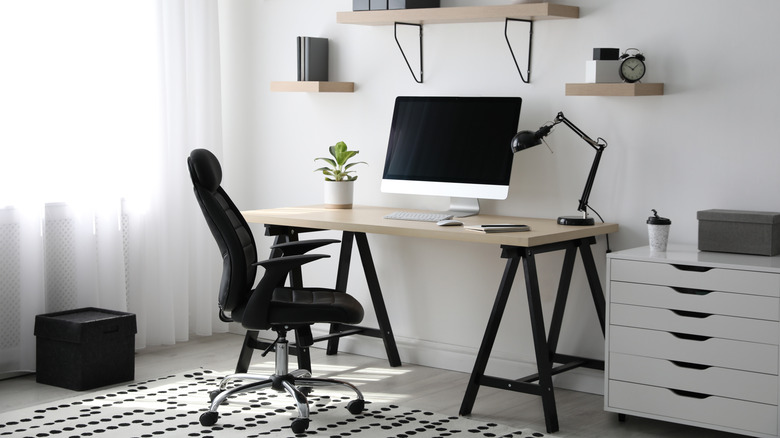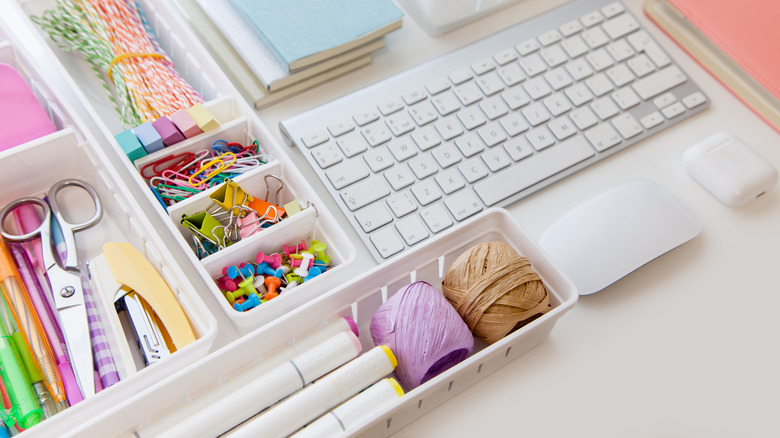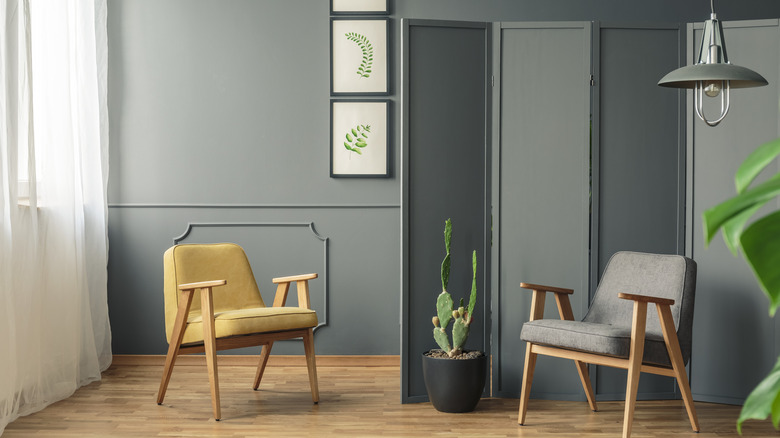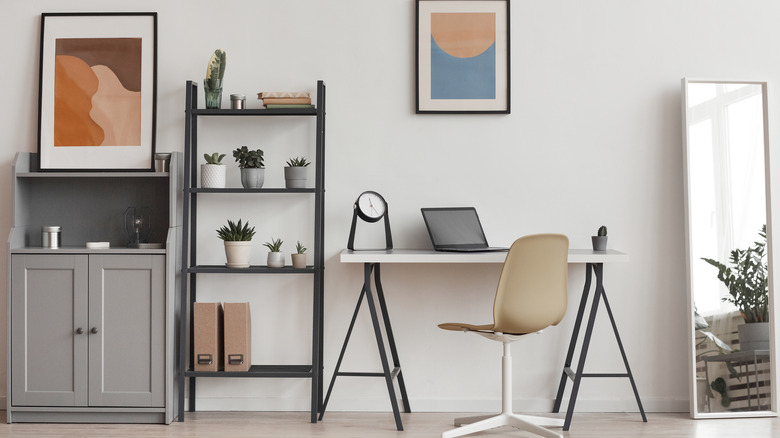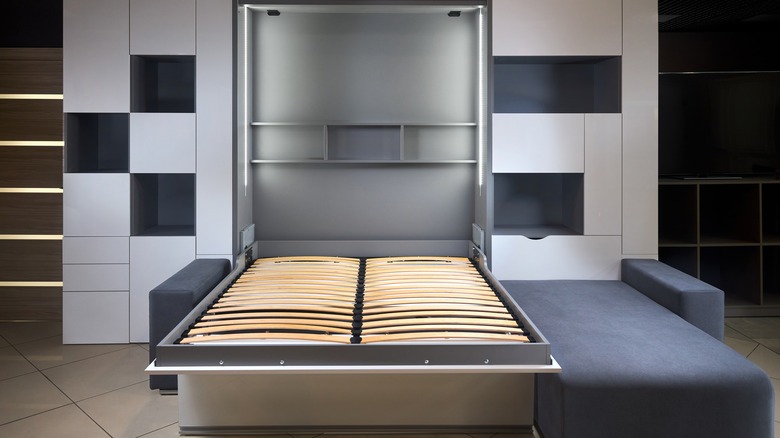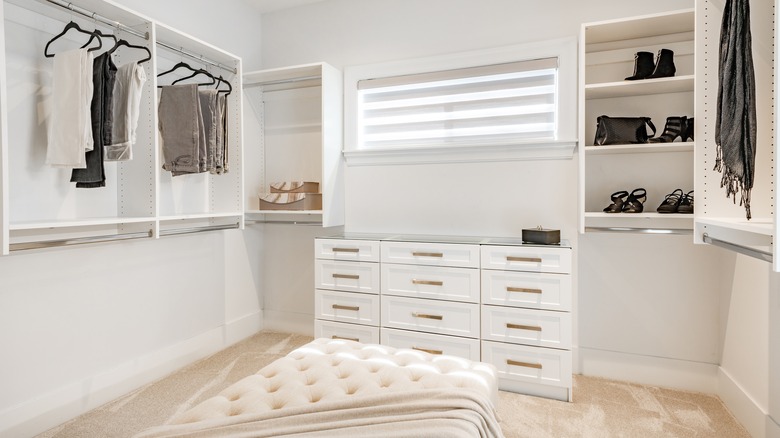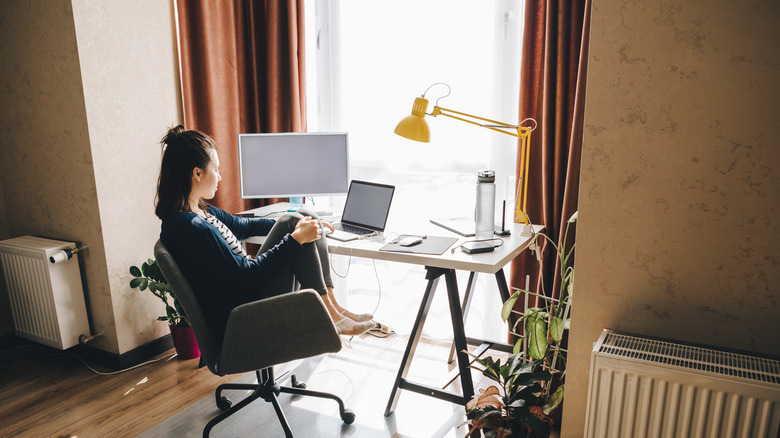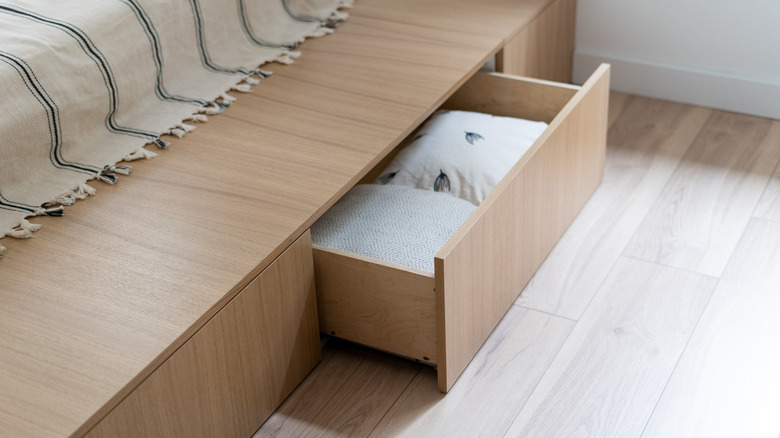How To Create An Office Space In Your Bedroom
A home office is necessary, whether you work from home full-time or are in a hybrid situation. However, you don't always have an extra room available for the office of your dreams. No worries. You can always carve out an office space in your bedroom. According to a survey from CraftJack, which surveyed 1,520 Americans working remotely, 31 percent of them created an office space in the bedroom, and 71 percent are improvising, which probably means they wing it each day. The average American household doesn't have much extra room after the bedrooms, living rooms, and recreation spaces.
A bedroom makes sense for your home office because it's often removed from the livelier areas of the home, making it easier to find some quiet. And don't worry, you don't have to prop up pillows and use a lap desk to be able to work from the boudoir. Even in a small area, there are creative ways to make office space in your bedroom.
Clean out the bedroom
Before adding something else to your bedroom, clean out the clutter. Is there anything not in use that you can get rid of to make a little more room? Clean spaces are essential. Psychology Today points out that too much clutter can make us feel stressed and disorganized, and it also sets us up to lose focus. Make your room less cluttered and free your mind.
The most challenging part of any job is getting started. Choose a corner or a closet and work your way out from there. Or pick what type of item you'd like to start with first. It can be clothes, paper, decor, or whatever else you have hidden in your bedroom. Primary bedrooms, especially, are a magnet for things with nowhere else to go. If you've decluttered before, you know the drill. Three piles: trash, keep, donate. The more you can get rid of, the more space you'll have for your home office in the bedroom.
After deciding what's trash, what you're keeping, and what you'll donate, get all those items into their place. Anything that stays needs a home and possibly a container. Next, thoroughly clean the room. Dust, mop, vacuum, and wipe everything down, including window treatments. Make your bed and make it a habit every day. An unmade bed in your office isn't motivating. Now your bedroom is a clean, blank canvas for an office space.
Choose a desk
You'll need a desk that can comfortably hold your computer, a pad of paper, and whatever else you use while at work. However, consider your health when choosing a desk. CNN reports we need to stand more and sit less. In the same report, Dr. Francisco Lopez-Jimenez said, "The reason [standing could be good] is because when we stand there are many muscles in our legs and butt and abdomen that are working to keep you standing. Whenever muscle is used, it consumes sugar and affects triglycerides." With this in mind, it's time to consider a standing desk for your home.
Standing desks either come at a fixed height or are adjustable, allowing you to move the height up and down so you can sit or stand. On average, a simple fixed desk can cost under $100, while an adjustable, electric desk may cost over $1,000 (via WebMD). It's an investment, but of course, worth it for the sake of your health. If you can't afford the adjustable or even a new fixed, standing desk, keep in mind that no matter where you work, you should move around or stand as much as you can throughout the day. For your bedroom office, opt for a work-from-home desk with a slim design, so it takes up less room.
Find a comfortable chair
While we've discussed the importance of standing while you work, you'll also be sitting often. Back pain can be an issue when working at a desk in the wrong chair. Consider purchasing an ergonomic desk chair for comfier work days. Ergonomic home office pieces are designed for back health and are often more adjustable than standard chairs. BTOD points out that ergonomic chairs encourage proper posture and hip alignment through lumbar support, taller backs, and adjustable armrests. They prevent slouching and are comfortable thanks to their contoured design. Whatever chair you choose, ensure the bottom half fits comfortably under your desk, so everything looks neat when you tidy up the room.
What do you look for in an office chair, other than one that's good for your back and fits under the desk? When shopping for a desk/office chair, check the armrests to make sure they're moveable, get seat dimensions to make sure your seat fits comfortably, and look for a chair with adjustable height (via Office Depot). Also, make sure the office chair is mobile. Most have wheels, and that's helpful when moving back and forth or getting out of the chair. You may want a rug or chair mat under your bedroom office chair for easier rolling. If you get tired of your feet dangling from your chair, invest in a footrest designed to go under the desk.
Add some office storage
Without a doubt, you have papers to file and things to keep in order. Keep it all organized so that your bedroom doesn't get out of control. A file cabinet is a perfect place to start for storage. You can keep one file cabinet for personal and work files or have two separate ones. To save space in your bedroom, get away with one if you can. Filling the Jars suggests storing as many files online as you can to save space around your desk. Some files we hang on to for the long-term don't need to be in print, sitting in a filing cabinet, and taking up space.
It's not just files that need organizing. A clean desk helps you to feel in control and ready to go. There are many desk organizers available to help keep pens, paper, paperclips, and other odds and ends at your fingertips and neatly organized. To save money, start collecting organizers around your home. Small boxes and empty containers from everyday items can be cleaned and used to hold things. For example, mason jars can hold pens and pencils. The cap from a can of hairspray can hold paperclips. When something at home is emptied out, rather than throw it away, use your imagination and see if it can help you organize your desk.
Separate the space
When a bedroom is for work and sleeping, it's important to separate the two areas as best as you can. You're only human, and a bed can be tempting. You don't want to trigger your mind into sleep mode. That probably won't bode well with your boss. Consider a decorative screen or a curtain to hide the office area from view. Sure, you'll know the bed is there, but at least it won't be staring at you while you're working.
Let's talk decorative screens. They are a quick solution, and one of the biggest perks is that they're portable and easy to move around. If you want to take them down temporarily or rearrange the room, it's not a big deal. Habitat for Humanity suggests using bifold closet doors as room dividers. It's easy to find secondhand bifold doors, especially at thrift stores and flea markets. Once you find the perfect doors, remove the hardware, clean up, and spray paint them any color you like. You can then put the hinges back on, and voila, you've got a room divider for your office. Repurposed bifold closet doors work just like a decorative screen.
You can also install curtain rods on the ceiling or along a wall if there is one, to hang a curtain and use as a room divider. Another item that works as a divider is furniture, particularly shelving. Bookshelves are also an attractive way to separate two different areas. The bonus is that they double as storage. The VITTSJO shelves from IKEA are ideal for dividing spaces. You can fill the shelves with houseplants, vases, photos, and other decorative keepsakes.
Let the decor work together
A cottage-style bedroom may not pair naturally with an office area, but you can make it flow with the right decor. Add some touches to help the office blend with the bedroom. If your bedroom has a color scheme, continue that in your office area. Consider how you want the entire room to feel and look when choosing office furniture and decor.
One way to make combining areas easier is to try a bit of minimalism. For a room that serves two purposes, minimalism can help tie the spaces together without much trouble. The goal of minimalism isn't to get rid of the things you enjoy in life. In fact, it's quite the opposite. According to LIFE Intelligence, minimalism is a practice that helps people feel more at home by disposing of anything in life that causes stress or hinders the ability to be productive and successful. That's not a bad idea for your office space at home. Your home office/bedroom should have as little distraction as possible. Decorate with the colors you love and add the decor in a way that ties everything together without creating distractions or daily chores to keep it all in order. Neutral paint colors are a good idea since they feel calming and cohesive. Use your time in the bedroom for your career and resting.ro
Opt for a non-traditional bed
If space is tight, a non-traditional bed may be your solution. Beds that are out of the way or that double as another piece of furniture will help open up the area in your bedroom office space. Three great options include the Murphy bed, loft bed, or futon. Murphy beds fold up to the wall when not in use, per Mattress Nut. You pull the bed down, out from the wall at bedtime, then push it back up to the wall when it's not in use. Some fold up against the wall, while others have a built-in, foldable cabinet on the wall. Murphy beds require the installation of a wall-mounting kit and, of course, some hefty installation if building a cabinet for the bed.
Loft beds are best for rooms with ceilings at least eight feet high. They are like a bed on stilts, with the bed off the ground, leaving space underneath. They're perfect when trying to save floor space. They also create the ideal hiding place for your desk. Since the area underneath a loft bed is partially enclosed, many people enjoy using it as an office (via Furnishing Tips). Ensure you light the space with task lighting like a desk lamp.
Lastly, a futon bed folds up as a couch when not in use. This option is ideal if you desire a seating area in your bedroom or office space. A futon couch works well for those times during work when you need to sit and read a long proposal or go over time-consuming documents. It provides another option besides your desk. Futons save space when it's not time for sleep and make your bedroom feel less like a bedroom while you're working.
How big is the closet?
Do you often joke that you could fit another room in your walk-in closet because it's so big? Now's your chance to make that a reality. Not everyone has a walk-in closet, but if you are lucky enough to have one, it can function as an office space. The first step, which you may have already done, is to get everything out of your closet so you can only put back what's really needed. You can try eliminating only one area or side of the closet to squeeze in a desk and a chair. Or, you can clear out the whole thing and store your closet items in a different way. CivicScience makes an interesting point about data showing a correlation between an increase in clothing purges and remote workers. Think about it ... do you need all your business suits and office clothing now that you're working from home? You might have more room in that closet than you realize. What if you no longer need it for your clothes at all?
If you're living without a closet, there are some tips that will help make your life easier. For example, you can install hanging rods in your room, purchase a hanging rack, turn a wall into an open closet by installing shelving, or try some wall hooks (via Minto). Those are some creative possibilities to make space in your walk-in closet. Once you've cleared the area, design your office space the same way you would if it were outside the closet. Keep how much room you have in mind.
Light everything up
If you can, place your desk near a window where you can get some natural light. It's normal to feel cooped up when working at home all day. A little natural light goes a long way. According to the Mayo Clinic, sunlight is essential and has many health benefits, including the production of vitamin D, bone health, lower blood pressure, the prevention of disease, and positive mental health. A little sunshine coming through your bedroom window while you work might boost your day and health.
If you can't benefit from the natural light of a window, do at least make sure you're getting enough light while you work. Lighting does more than keep the room from being dark. Poor lighting has some negative effects. For example, poor lighting in the workplace can cause headaches, eye strain, neck and back pain from incorrect posture caused by leaning uncomfortably to see the computer, and in the end, a decrease in productivity (via Perfect Pollucon Services). Even if your workplace is just a corner in the bedroom, it's still your workplace. Consider a desk lamp if necessary or a floor lamp right next to the desk. You can even get floor lamps with artificial sunlight to help with those long winter days when working from home.
Invest in multi-purpose furniture
Using furniture that serves more than one purpose will allow your office space to be stylish and practical without overwhelming the space. Look for items like bookshelves with a fold-down desk or beds with under-bed storage. Coaster Fine Furniture points out that multifunctional furniture allows homeowners to save money in a variety of ways. First, when you want to change things up, you can use your multitalented piece in a new way, rather than running out to buy something else. Second, when using something that can double as another item, you immediately save money by not having to buy two different things. Space and cost savings make it a win-win situation.
As mentioned, bookshelves are incredible multi-purpose furniture pieces. They can store anything, including files, books, office supplies, plants, artwork, and decor that will help brighten your day. They, of course, make an excellent room divider as well. Day beds, futons for extra seating, and an ottoman that opens for storage can all double as a place to put your feet up while you work. If you can, look for a bedframe with under-bed storage. Store work-related items or use the storage drawers as a place to put your clothing removed from the closet.
In conclusion, creating a home office in your bedroom is about designing a bright and cheery space that serves you well and doesn't take over the bedroom. When creating a home office in your bedroom, prioritize comfort, health, storage space, and separation from the sleeping area.


